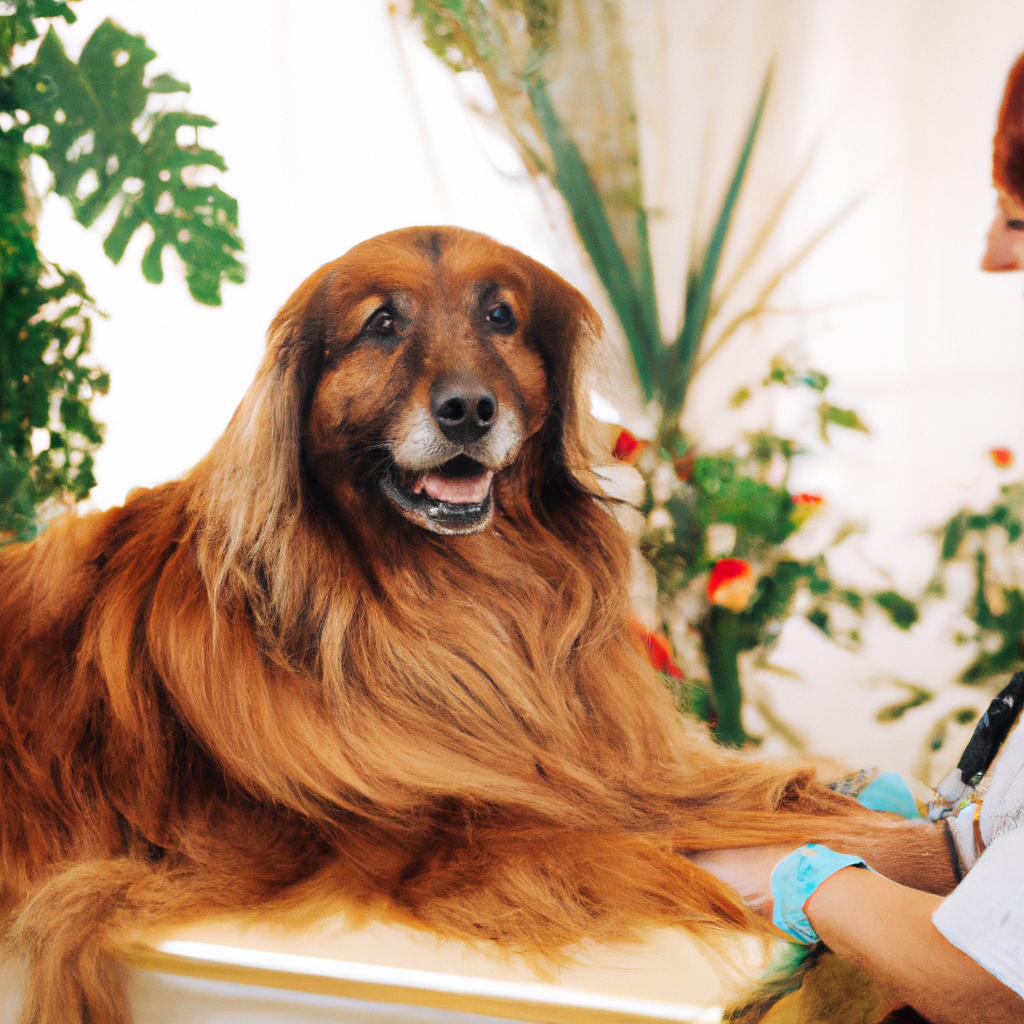Strolling through the serene corridors of a bustling hospital, one might expect to find the usual array of medical equipment, attentive doctors, and diligent nurses. But what if, amidst the clinical atmosphere, a wagging tail caught your eye or a gentle purr resonated through the hallways? Animal-assisted therapy, a unique and enchanting approach to healing, is captivating the hearts and minds of patients and healthcare professionals alike. In this article, we delve into the world of this extraordinary therapeutic intervention, where the innate connection between humans and animals proves to be an extraordinary catalyst for healing. Immerse yourself in the captivating realm of animal-assisted therapy, as we explore the profound impact it has on humanity’s quest for healing and recovery.
1. Paws for Healing: The Incredible Power of Animal-Assisted Therapy
Animal-assisted therapy, also known as AAT, is a captivating field that explores the miraculous power of animals in healing the mind, body, and soul. Many studies have shown the numerous benefits that occur when animals, such as dogs, cats, horses, or even dolphins, are incorporated into therapeutic interventions. These incredible creatures possess a unique ability to provide comfort, support, and a sense of well-being to individuals undergoing various forms of therapy.
One remarkable aspect of animal-assisted therapy is its profound impact on mental health. Spending time with animals has been proven to reduce stress levels, anxiety, and symptoms of depression. Interacting with animals can release endorphins, boosting mood and enhancing overall mental well-being. Furthermore, the unconditional love and non-judgmental nature of animals creates a safe space for individuals to express their emotions and connect with their inner selves.
Aside from benefiting mental health, animal-assisted therapy is also known to improve physical health. Engaging in activities with animals can encourage movement, improve motor skills, and strengthen muscles. For example, individuals recovering from injuries or surgeries may participate in equine therapy, where horseback riding can help improve balance and coordination. Additionally, animals can be trained to assist individuals with physical disabilities in their daily activities, such as fetching objects or opening doors.
In addition to its effects on mental and physical health, animal-assisted therapy provides remarkable social benefits. Animals act as social catalysts, breaking down barriers and encouraging positive interactions between individuals. Animal interactions can facilitate communication, improve social skills, and increase feelings of connectedness and inclusion. This makes animal-assisted therapy particularly beneficial for those who struggle with social anxiety or find it challenging to engage in therapeutic settings.
Animal-assisted therapy is a versatile intervention that can be applied in various settings, including hospitals, nursing homes, schools, and prisons. Whether it’s petting a therapy dog during a hospital visit or engaging in equine therapy for trauma recovery, the incredible bond between animals and humans has the potential to create transformative healing experiences. The power of animals to guide individuals towards emotional, physical, and social well-being is truly awe-inspiring and continually unfolds new opportunities in the world of therapy.
2. Unleashing Hope and Happiness: How Animals Aid in Human Recovery
Humans have long recognized the therapeutic power of animals. From ancient civilizations to modern times, our furry, feathered, and scaly friends have played a pivotal role in supporting individuals in their journey towards recovery and well-being.
1. Emotional Support: Animals have an innate ability to connect with us on a deep emotional level. They provide unconditional love, non-judgmental companionship, and a sense of belonging. In times of recovery, this emotional support becomes a lifeline for individuals suffering from various physical and mental health challenges.
2. Reduced Stress and Anxiety: Interacting with animals has been scientifically proven to reduce stress and anxiety levels. Their calming presence and playful nature can help lower blood pressure, regulate breathing, and release endorphins – the “feel-good” hormones, which create a sense of relaxation and well-being.
3. Physical Rehabilitation: Animals can also aid in physical recovery. Therapeutic horseback riding, known as equine-assisted therapy, helps improve balance, coordination, and muscle strength. Similarly, dolphins are known to assist in rehabilitation by encouraging movement and enhancing motor skills. These mindful interactions with animals empower individuals to regain physical abilities and enhance overall mobility.
4. Social Connection: Animals act as social catalysts, creating opportunities for humans to engage and connect with each other. Whether it’s taking a walk with a dog, attending a therapy session with an animal present, or participating in an animal-assisted group activity, the presence of an animal can break down barriers and facilitate meaningful human interactions.
5. Increased Positivity and Motivation: Animals have an incredible ability to bring joy and spark motivation within individuals. Simply watching a dog wag its tail, witnessing a cat’s playful antics, or observing the beauty of nature through birdwatching can rejuvenate the spirit and instill a renewed sense of hope and happiness in those going through the recovery process.
These examples merely scratch the surface of the immense benefits animals offer in aiding human recovery. Their ability to heal and inspire is a testament to the profound bond between humans and animals, reminding us that sometimes, all we need is a furry friend to help us unleash hope and happiness.
3. Tail-wagging Therapy: The Science Behind Animal-Assisted Healing
Have you ever wondered why spending time with animals can have such a profound effect on our well-being? It turns out there is a scientific explanation behind the healing power of our furry friends. Animal-assisted therapy (AAT), also known as pet therapy, has gained considerable recognition in recent years for its ability to improve mental, emotional, and even physical health.
When we interact with animals, our bodies release a hormone called oxytocin, often referred to as the “bonding hormone.” This hormone plays a crucial role in social bonding and reducing stress, promoting feelings of love, trust, and connection. The presence of animals during therapy sessions can increase oxytocin levels in both adults and children, creating a sense of calmness and enhanced communication.
Animal-assisted therapy has been proven to have a wide range of benefits. Here are just a few:
- Reduced anxiety and stress: Interacting with animals has a soothing effect on our nervous system, lowering our heart rate and blood pressure. It can provide a welcome distraction from everyday worries and help us relax.
- Improved emotional well-being: Animals are incredibly perceptive and have a special ability to empathize with human emotions. They can offer comfort and support during times of sadness, grief, or trauma.
- Increased socialization: Animal-assisted therapy encourages individuals to connect with others in a non-threatening and non-judgmental way. This can be particularly beneficial for those struggling with social anxiety or isolation.
- Enhanced physical health: Interacting with animals can have physical benefits such as reduced pain, improved motor skills, and increased motivation to engage in physical activity or rehabilitation.
Animal therapy is not limited to dogs; various species, including cats, horses, guinea pigs, and even birds, can offer therapeutic benefits. AAT is now widely used in hospitals, schools, nursing homes, and rehabilitation centers to complement traditional treatment methods and support patients on their healing journeys.
Next time you see a wagging tail or a gentle purr, remember that behind those adorable gestures lies a powerful scientific force that can bring comfort, joy, and healing to those in need.
4. Furry Angels: Exploring the Profound Impact of Animals on Human Well-being
Animals have an inherent ability to touch our souls and bring immense joy into our lives. Their unconditional love and companionship have been celebrated for centuries, and recent studies have shed light on the profound impact they have on human well-being. From reducing stress and anxiety to promoting physical fitness and emotional healing, these fuzzy angels have a way of improving our lives in ways we never imagined.
Stress Relief: The simple act of petting an animal, feeling their warmth and hearing their content purrs or gentle chirps, can melt away the tensions of even the most challenging day. Interacting with animals has been shown to lower blood pressure, decrease cortisol levels, and release endorphins, all contributing to a significant reduction in stress and anxiety. So, next time you’re feeling overwhelmed, embrace the furry angel within arm’s reach and let them work their magic.
Emotional Support: Animals have an incredible capacity to provide emotional support, particularly for those facing difficult times or struggling with mental health issues. Their unwavering presence and ability to empathize without judgment create a safe space where humans can freely express their emotions. Whether it’s the comforting presence of a therapy dog during a therapy session or the warm nuzzles of a cat after a long day, these furry angels can offer a sense of solace and understanding that words alone often cannot.
Physical Health: Beyond their emotional impact, animals also contribute to our physical well-being. Walking a dog, for instance, not only offers exercise but also encourages regular outdoor activity. The bond formed with our pets often motivates us to adopt healthier lifestyles, leading to weight loss, increased cardiovascular fitness, and improved overall health. Furthermore, studies have shown that interaction with animals can even boost our immune system, potentially reducing the risk of allergies and asthmatic conditions.
Social Connection: Animals act as social catalysts, easily breaking down barriers and initiating conversations among strangers. Whether it’s at a dog park, while volunteering at an animal shelter, or even through the simple act of walking your four-legged companion, pets offer a common ground for people to connect and forge new friendships. They can enrich our lives by fostering a sense of community and companionship, combating feelings of isolation and loneliness.
In a world where stress and challenges are ever-present, it’s clear that our furry angels play a vital role in improving our overall well-being. From boosting our mood and physical health to promoting social connections, animals have the power to enhance our lives in surprising and extraordinary ways. So, let us cherish and celebrate these incredible creatures who bring us so much happiness and love. After all, they truly are our furry angels.
The journey of animal-assisted therapy has just begun, and researchers are still discovering not only the ways in which animals can help humans heal, but also how to make these treatments more accessible to everyone. It’s amazing to see how far we’ve come in understanding how humans and animals can together create a bridge to well-being and health. As long as we take steps forward to make animal-assisted therapy a reality, it won’t be long until we’re seeing the full potential of this mutually beneficial therapy everywhere!


